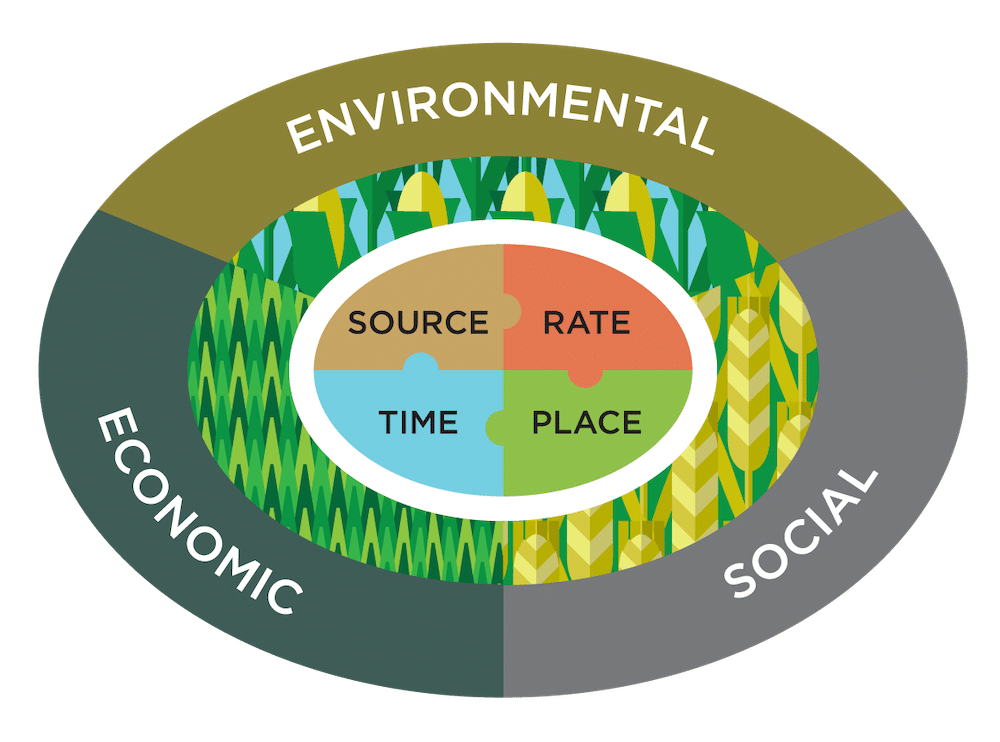Nov 12, 2025



Every growing season has its challenges. This season, even with persistent drought across the Western half of the US and late planting in the Midwest, fertilizer costs and availability dominate local coffee shop conversations.
Global conflicts, labor shortages, and high gas prices continue to squeeze supply chains and push fertilizer prices to record highs. For example, at the start of 2021, the average price of anhydrous ammonia fertilizer was $432 per ton. Just a year later, even before the Russia-Ukraine conflict, it hit an all-time high of $1,492 per ton.
Let’s break that down with a practical example: for a corn grower in Michigan applying fertilizer at a 180-70-70 rate, this averages out to a $115 increase per acre compared to 2021 – or just over $250 an acre total.
While commodity crop prices remain strong, it’s imperative growers ensure their nutrient management programs operate on all cylinders to keep yield potential high despite these limiting factors. The key to squeezing every ounce of yield out of your fertilizer program is maximizing your soil’s health and quality to improve nutrient use efficiency (NUE) throughout the growing season.
For successful holistic land management plans, you need to address the three spheres affecting your soil’s quality and eventual crop yield: the chemical, the physical, and the biological. These three spheres all affect each other and overall soil quality. Soil quality refers to its ability to do its job, whether it is agricultural soil or forest loam. In the case of your farm’s soil, its job is to support healthy crops and maximum yield with a minimum number of inputs.
Chemical: The chemical aspect of soil is what we attempt to manage when we apply fertilizer and different nutrients to our fields. This includes the nutrients available in a particular soil, the soil’s pH (how acidic or basic it is) and the cation-exchange capacity (CEC), which is a measure of how well a soil “holds” on to nutrients.
Physical: When you grab a handful of healthy soil and admire its chocolate cake texture (or more technically known as granular structure), you’re assessing soil’s physical properties. Soil structure, texture, and color are all physical properties positively affected by holistic land management practices.
Biological: The biological aspect of your soil refers to all the living things calling your soil home, both visible (e.g., earthworms) and invisible (e.g., bacteria and fungi). The invisible powerhouse of your soil is known as the soil microbiome and is a key player in building soil quality and structure, which in turn support nutrient availability.
The biological sphere is often the last addressed in land management practices, despite the soil microbiome being the driving engine of the soil ecosystem supporting crop life. Crop-beneficial bacteria and fungi are responsible for transforming nutrients into plant-available forms and cycling those nutrients throughout the soil and the rhizosphere (root zone) – this includes nitrogen, the nutrient most responsible for a crops ability to grow and thrive through the season.
There are practical steps growers can take to boost the biological sphere that will positively affect the chemical and the physical – stretching your fertilizer investment further in a variety of ways.
Imagine someone blew the roof off your office or kicked the tires off your tractor, and this happened every single season. You probably wouldn’t get much work done! This is also true of the beneficial microbes that live and work in your soil. Disturbing the soil disrupts the work that microbes do and makes it hard for them to live. By reducing tillage, keeping soil covered, and investing in cover crops to keep a living root in the soil, you’re providing an ideal work environment for your native microbes to do the important jobs they do for your soil and your crop.
Not only do beneficial microbes need a stable environment to thrive, they also need a quality food source. This is where a carbon product like PhycoTerra can be useful on your farm. Feeding the soil microbiome PhycoTerra activates a diverse population of soil microbes, attracts them to the root-zone of the plant, and puts them to work to optimize soil health. Different microbes do different jobs for your soil and your crop, so it’s important to feed native microbes a balanced superior food source like PhycoTerra to promote microbial diversity and abundance.
Beneficial microbes activated by PhycoTerra can help growers get the maximum amount of yield per unit of fertilizer (this is called “use efficiency”) by:
Soil with excellent structure and water infiltration resists water and wind erosion, run-off, and leaching, keeping more nitrogen in the root zone where it belongs. Water holding capacity is important to support crops experiencing drought.
Beneficial microbes transform nutrients, like nitrogen, into forms a plant can use and easily digest and carries these nutrients to the plant when they need them throughout the crop’s growing cycle.
For example, California growers have seen up to a 20% increase in nutrient use efficiency, specifically with nitrogen, while using PhycoTerra as a complement to their nutrient management programs – that’s 20% more almonds for every unit of nitrogen fertilizer, while at the same time optimizing soil health for their farm and future crops.
We have also seen positive improvements in nutrient use efficiency across commodity crops in our third-party trials: corn (6.8%), soybeans (5.9%), wheat (5.1%), and canola (4.5%). PhycoTerra can easily be mixed with a variety of liquid fertilizers, making it easy to include in your nutrient management programs.

Figure 1: Add PhycoTerra soil microbial food to your liquid fertilizer program to help make your fertilizer investment go further. PhycoTerra has a flexible application window and can be applied post-emergence.
Apply the right source of nutrient, at the right time, and in the right place to optimize the efficiency of fertilizer use and improve NUE. The goal of 4R nutrient stewardship is to match nutrient supply with crop requirements, minimize nutrient losses from fields, and maximize farmer profitability. When you integrate a superior carbon product like PhycoTerra into these practices, you’re giving your soil and your crop the best chance of getting the nutrients it needs, when it needs them.
Right Source – Understanding your options and utilizing the right source of nutrient – whether that is a synthetic fertilizer (e.g., urea), an organic nutrient source like a cover crop, manure, or compost, or a carbon product – is essential to finding the most efficient blend to match your crop’s needs.
Right Rate – Soil testing and understanding individual crop demand is key to building a nutrient program targeted field by field. Frequent soil testing also allows the grower to see the effect of land management changes in real time and adjust accordingly.
Right Time – Assess dynamics of crop uptake, soil supply, nutrient loss risks, and field operation logistics (post emergence and side dress applications). Avoid loss to erosion, surface runoff, and leaching (carbon products can help support this as well).
Right Place – Root-soil dynamics, nutrient movement (active soil microbes and improved soil structure) to limit potential nutrient losses.

Figure 2: There are several N-loss pathways that we are trying to reduce by applying PhycoTerra and improving soil health and NUE. Growers are constantly fighting against these N-loss pathways to maximize their fertilizer investment. Farm Progress: Pay Attention to Nitrogen Loss Pathways
The practices we have discussed – utilizing cover crops, feeding soil biology, reducing tillage – are what growers need to realize optimal nutrient management for their crops in a volatile fertilizer market and extreme drought conditions to maximize their potential yield. They also happen to be key practices in nutrient stewardship, conservation, and regenerative agriculture.
While fertilizer prices are optimistically expected to cycle down again long-term, the regulatory and social scrutiny on synthetic fertilizer will likely remain for some time due to its impact on climate change and water pollution. Nitrogen isn’t “the bad guy” – it’s just an element, and it’s a key nutrient crops, animals, and humans need to survive. Without nitrogen fertilizer, it’s calculated we’d have only have enough food to feed 50% of the global population.
On the other hand, the agricultural nitrogen cycle, with all its real-world challenges, is far from a closed loop. When nitrogen applied to the soil isn’t absorbed by the plant, it can leave the root zone and be lost to leaching (water pollution), surface runoff, and the atmosphere (greenhouse gas emission). When nitrogen is lost, everyone loses – the plant, the Earth, and the grower.

Figure 3: Improving nutrient use efficiency (NUE) through 4R practices benefits the grower (protects and maximizes fertilizer investment) the consumer (social benefit of reduced food insecurity) and the planet (environmental gains by reducing water and air pollution). Nitrogen: A Complex Reality | Clean Water Iowa
Any grower knows farming is unpredictable – so let’s control the things we can. Synthetic fertilizers have supported maximized yields per acre and global population to boom – fertilizers are a critical part of the food supply chain. The challenge the fertilizer frenzy of this growing season is bringing into focus is: how do we maximize NUE and create long-term, sustainable, and resilient agricultural practices and technologies that benefit growers, consumers, and the planet?
Add PhycoTerra to your side-dress and post-emergence input strategy to optimize your NUE and fertilizer investments this year.
Note: All trial data is current as of blog posting. For the most up to date trail data, please visit our trials page.